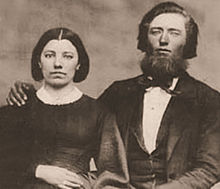
I said in an earlier post that I wanted to explore further the life of Laura Ingalls Wilder’s mother, Caroline, called “Ma” in the books. The more I’ve read about her the more fascinating she’s become. As I’ve re-read some of the Little House books, especially the first one, Little House in the Big Woods, I’ve been more and more impressed with how much sheer practical knowledge about survival both she and Pa had. I had thought originally that Ma had come from a pampered city life because of a passage that shows up in this first book about Ma’s best dress, her “delaine.” Pa has just come home from visiting his father to help with making maple syrup and says that there’s going to be a “sugaring off” party with a dance included.




 My husband listens to a podcast called “The Art of Manliness,” but it should really be called “The Art of Living Well.” They’re up to well over 500 episodes, with different guests and topics.
My husband listens to a podcast called “The Art of Manliness,” but it should really be called “The Art of Living Well.” They’re up to well over 500 episodes, with different guests and topics.  I wrote last week about my accidental weight loss of 2-3 pounds and how I’m trying to hang onto it. So far, so good. Yesterday was 115.5. I have my A1C reading on Friday, so we’ll hope that’s okay, too. But, just to show that life is always throwing a curve ball, that very same Wednesday I started getting sick, which doesn’t happen too often. Once in a while, though, maybe every other year or so, my chronic allergies and my chronic sinus problems combine to give me an actual infection. Nothing serious, and I’m not going to share any gross details about nose blowing or anything, but I was laid low through Monday after caving in and going to a doctor last Friday. Once I started in on antibiotics there was a definite improvement, but the process took several days. No floor exercises or walks took place during that time, and then we started in with snow and cold as of Tuesday. I wasn’t going to get out on the trail with those conditions, so the dreaded treadmill was in the cards. I wimped out yesterday but finally got myself upstairs today, putting in 45 minutes at a fairly slow pace and also doing a full round of the floor thingies. (I should do a post sometime about what I do, but it would have to involve a video. Have to think about that one. Let me just say here that I’m a firm believer in doing something simple and short, qualities that make the routine much easier to stick with.) In theory I’m back in the saddle.
I wrote last week about my accidental weight loss of 2-3 pounds and how I’m trying to hang onto it. So far, so good. Yesterday was 115.5. I have my A1C reading on Friday, so we’ll hope that’s okay, too. But, just to show that life is always throwing a curve ball, that very same Wednesday I started getting sick, which doesn’t happen too often. Once in a while, though, maybe every other year or so, my chronic allergies and my chronic sinus problems combine to give me an actual infection. Nothing serious, and I’m not going to share any gross details about nose blowing or anything, but I was laid low through Monday after caving in and going to a doctor last Friday. Once I started in on antibiotics there was a definite improvement, but the process took several days. No floor exercises or walks took place during that time, and then we started in with snow and cold as of Tuesday. I wasn’t going to get out on the trail with those conditions, so the dreaded treadmill was in the cards. I wimped out yesterday but finally got myself upstairs today, putting in 45 minutes at a fairly slow pace and also doing a full round of the floor thingies. (I should do a post sometime about what I do, but it would have to involve a video. Have to think about that one. Let me just say here that I’m a firm believer in doing something simple and short, qualities that make the routine much easier to stick with.) In theory I’m back in the saddle. There’s been a friendly rivalry of sorts going on at our church between another woman and myself over who gets to do what food events. Neither one of us is actually running a business per se, but we both enjoy(?) putting on big meals. I had done our church Christmas party dinner (60-75 people) for about three years, then I said it was just too much. So my friendly rival (henceforth designated FR) took it over and did a spectacular job. I stayed out of the fray except for making desserts and my famous pink eggnog for several years, but then I sort of missed it. Last year I asked the woman in charge if I could do it. “Oh, I’m so sorry, but FR already asked if she could do it again this year, and I said yes.” So I stuck with my usual role. FR had also done the food for our annual women’s retreat for a couple of years, with the 2018 one being especially good. She made her grandmother’s green chile (chili? I can never remember when to use which spelling), and it was awesome. Plus she made this cold strawberry soup for dessert. Man! Plus, she made some little chocolate tarts that were . . . vegan. And in spite of that drawback they were honestly one of the best things I have ever put in my mouth. So rich!
There’s been a friendly rivalry of sorts going on at our church between another woman and myself over who gets to do what food events. Neither one of us is actually running a business per se, but we both enjoy(?) putting on big meals. I had done our church Christmas party dinner (60-75 people) for about three years, then I said it was just too much. So my friendly rival (henceforth designated FR) took it over and did a spectacular job. I stayed out of the fray except for making desserts and my famous pink eggnog for several years, but then I sort of missed it. Last year I asked the woman in charge if I could do it. “Oh, I’m so sorry, but FR already asked if she could do it again this year, and I said yes.” So I stuck with my usual role. FR had also done the food for our annual women’s retreat for a couple of years, with the 2018 one being especially good. She made her grandmother’s green chile (chili? I can never remember when to use which spelling), and it was awesome. Plus she made this cold strawberry soup for dessert. Man! Plus, she made some little chocolate tarts that were . . . vegan. And in spite of that drawback they were honestly one of the best things I have ever put in my mouth. So rich!
